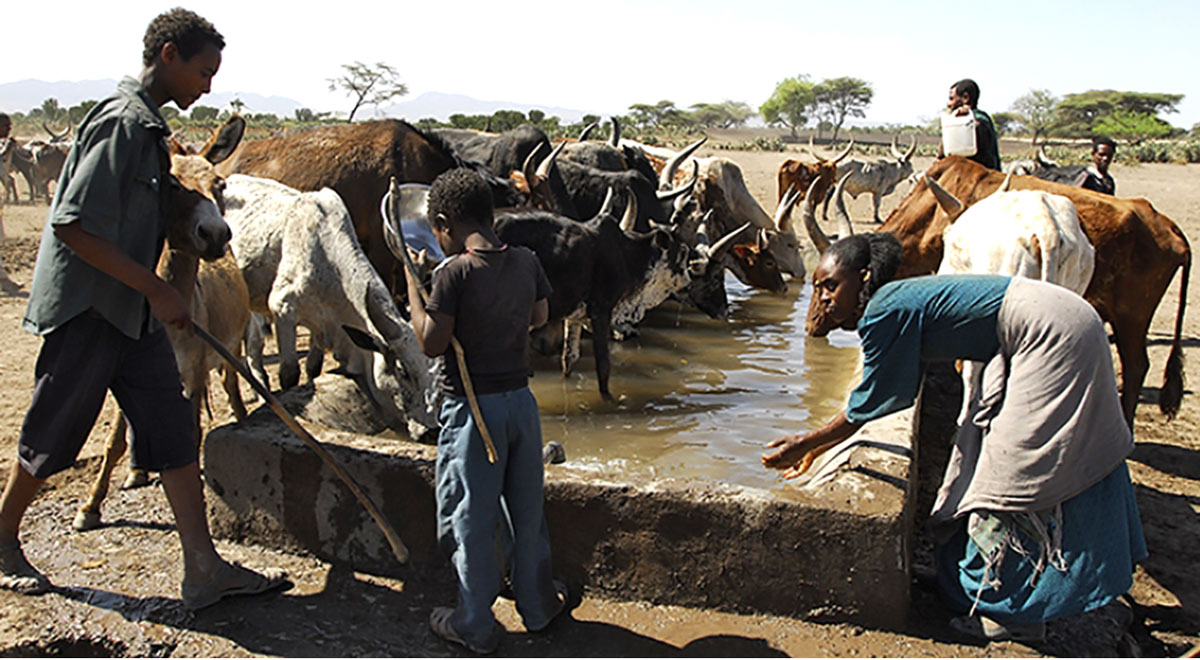Social scientists at The Bartlett worked with epidemiologists, immunologists and geneticists to tackle the spread of bovine TB in Ethiopia’s burgeoning dairy industry.

A cattle farm in Ethiopia. Credit: Unicef
Ethiopia has the largest livestock population in sub-Saharan Africa: almost 57 million cattle share the country with its 85 million human inhabitants. But the type of cow traditionally farmed there – the zebu – is not great at producing milk.
The government sees the country’s cattle farming tradition as having huge potential for developing a dairy industry that not only meets national demand (currently milk powder has to be imported from Switzerland), but could also allow exports to China, Saudi Arabia and elsewhere. So since the 1990s, it has been encouraging intensive dairy farming with plans to grow the contribution of dairy industry to the national economy.
Building up that industry depends on introducing ‘exotic’ breeds, such as Holstein-Friesians, which are better milk producers. But there’s a huge risk in doing this: those breeds appear to be more susceptible to bovine TB than the native zebu. And bTB is a zoonotic disease – like Ebola, avian flu and SARS – which means it can jump the species divide between animals and humans and spread rapidly, especially in areas of widespread poverty where food safety regulations and health systems are weak.
The social science of disease control
Between 2014 and 2020, The Bartlett’s Institute for Global Prosperity (IGP) worked with eight collaborating institutions on the Ethiopia Control of Bovine Tuberculosis Strategies (ETHICOBOTS) project. This interdisciplinary project brought together epidemiologists, immunologists, geneticists and social scientists from Europe and Ethiopia to develop systems to ‘clean’ the country’s cattle stock of bTB. The aim was to minimise the potential impact of the disease on poor high-risk groups, as the emergent dairy livestock system continues to expand.
Most of Ethiopia’s cattle, particularly exotic and cross-breeds, are farmed in small herds of under 10 animals by families who work in close contact with their animals, and for whom a cow is by far the most valuable possession. If a cow becomes sick, the farmers readily admit, they would receive no compensation from government and could not afford to slaughter it. Instead, they would not report the problem and sell the cow somewhere far away.
So while developing a major dairy industry could boost Ethiopia’s national economy, with little past experience of controlling bTB, and no system in place for monitoring it or insuring farmers against it, intensive dairy farming involving susceptible breeds poses a significant risk: it could rapidly spread bTB across the country. It could destroy many poor families’ livelihoods as well as affecting public health, food production and the wider economy. In a landlocked country in the Horn of Africa, there is also the potential for the disease to spread to some of the region’s most troubled nations – Somalia, Sudan, South Sudan.
Developing sustainable strategies
The ETHICOBOTS project gathered data on the prevalence of bTB in Ethiopia. It found that in some exotic cattle in intensive dairy farms in central Ethiopia, the prevalence of bTB is more than 30%, while in zebu it is between 0 and 19%.
The project developed sustainable strategies for controlling the disease. It examined the management of sickness and health both in smallholder households, and on emerging commercial dairy farms. It also studied new consumption patterns, more intensive animal husbandry techniques, formal and informal trade networks of cattle and dairy products, an increasing labour burden and attitudes to risk and decision-making.
IGP’s part in the project was working with affected communities – making sure that strategies suggested by the natural scientists to prevent and control the disease in both cows and humans made practical sense to the people who make their living from dairy farming. Achieving that involved exploring participatory methods for disease surveillance using mobile phones and developing simple farmer-led monitoring systems for intervention programmes.
“We are working with and listening to the farmers – that way they are more likely to report problems and become reliable sources of surveillance data,” said Catherine Hodge, a PhD Candidate at IGP who investigated systems and technologies that could be used to help farmers understand risks and share information.
At the same time, IGP worked with government officials to create policy notes that will inform the development of new guidelines and a set of evidence-based, appropriate interventions to minimise the burden of bTB.
 Close
Close




